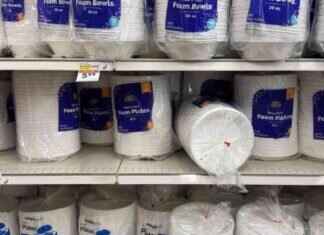Business of Arms in the Middle East: Weapons, War, Wealth.
Amidst the backdrop of global turmoil and regional conflicts, the International Defense Exhibition and Conference held at Abu Dhabi, United Arab Emirates, showcased a...
The Rise of Two-Minute TV Shows: Global Takeover?
The rise of micro dramas, also known as vertical dramas, has taken the entertainment world by storm, captivating audiences with bite-sized episodes that pack...
Top 10 Books to Read in March
As the month of March unfolds, the literary world is abuzz with a fresh selection of captivating reads that promise to transport readers to...
Innovative Desalination Technology Testing in California to Lower Costs
Californians may soon find themselves sipping water sourced from the Pacific Ocean off Malibu, thanks to a groundbreaking desalination technology currently under testing. OceanWell...
EPA’s New Regional Administrator in Charge of California & Pacific Southwest
President Trump recently appointed Josh F.W. Cook as the new administrator of the Environmental Protection Agency (EPA) for California and the Pacific Southwest, marking...
Protesters gather against Trump, Musk in Westwood
Hundreds of passionate individuals gathered in Westwood to express their discontent with President Trump and Elon Musk's actions. The protest was notably attended by...
Arrest of Cal Fire captain’s wife in Mexico
The arrest of Cal Fire captain's wife in Mexico has sent shockwaves through the community, as Yolanda Olejniczak Marodi, the prime suspect in the...
Fatal Wrong-Way DUI Crash on 60 Freeway in Pomona
A tragic incident unfolded on the 60 Freeway in Pomona on a fateful Saturday night, claiming the lives of two women and leaving a...
Restaurant Utility Worker: Essential Behind-the-Scenes Role
In the bustling kitchen of Chapter One, a beloved neighborhood gastropub in downtown Santa Ana, there is a man who moves with a sense...
Insights on American Wine: Tasting 394 Wines in One Day
In the world of wine, tasting can be a laborious task, requiring focus, dedication, and a discerning palate. It's not just about sipping casually...
Xbox Creator Innovates Lab-Grown Chocolate: L.A.’s Willy Wonka?
Seamus Blackley, the mastermind behind Microsoft's Xbox console, has embarked on a new, tantalizing venture within the walls of Pacific Light & Hologram in...
Mourning the Loss of Mom at Disneyland
Mourning the Loss of Mom at Disneyland
Losing a loved one is a deeply personal and emotional experience that can shake us to our core....
Letting Go: Moving On from Husband’s Pickup Truck
As I sat in the passenger seat of Stephen Beech's pickup truck on Valentine's Day in 1993, little did I know that this vehicle...
Saving L.A.’s Oldest Restaurant: Can a New Bar Help?
The future of Chili John's, a beloved Burbank institution since 1946, hangs in the balance as the iconic restaurant faces the threat of closure....
California Dairies Closing Sparks Conservation Concern in Point Reyes
Amidst the picturesque setting of Point Reyes Station, California, where fog-kissed streets are lined with quaint bakeries and artisanal cheese markets, a storm of...
Mother charged with murdering son in O.C. hotel
A mother has been charged with the murder of her 11-year-old son in a tragic incident that unfolded during what was supposed to be...
Sibling Questions Sister’s Death: Suicide or Something Else?
In James Whitfield Thomson's "A Better Ending," the author embarks on a twenty-year quest to uncover the truth behind his sister Eileen's death in...
Simplifying Life in ‘The Colony’: A Review
Burnout has been a universal struggle for centuries, as evidenced by Henry David Thoreau's lament in 1854 about lives being "frittered away by detail."...
Top 4 Must-Read Mystery Books for You
In this ever-evolving world of crime novels, the options seem endless, with so many intriguing titles vying for our attention and limited time. As...
Krysten Ritter’s Compelling Antihero: A Review
Krysten Ritter's Dynamic Dive into Antihero Territory
Krysten Ritter, known for her role in the Marvel series "Jessica Jones," takes a daring leap into the...
Capitulation to Trump: A Dangerous Contributor
In a recent turn of events, both a prestigious law firm and Columbia University have made the surprising decision to surrender to President Trump’s...
Top 10% Wealthy Americans: Will They Help Struggling Americans?
In a small town like Chelsea, Mass., the local residents received a helping hand from a food bank just before Thanksgiving last year. This...
Americans Taking on Trump Without Waiting for Democratic Party
Americans across the country are feeling a deep sense of shock and despair as they witness President Trump's relentless assault on our nation's institutions....
Stop Obstructing Venice Dell Homeless Housing Project: Build Now
The Venice Dell Homeless Housing Project has been mired in bureaucratic delays and obstacles since its inception in 2017, despite being approved twice by...
Are Adults-Only Hotels Legal in California?
The debate over whether hotels can legally ban children in California has sparked interest and controversy among travelers and industry experts alike. With spring...
Fire Hydrant Repairs: DWP Successfully Addresses Issues
The Los Angeles Department of Water and Power has made significant progress in addressing fire hydrant repairs following a delay in receiving inspection results...
Living Hell: Eaton Fire Survivors Share Their Struggles
Living Nightmare: Eaton Fire Victims Share their Ongoing Struggles
In the quiet living room of her modest two-bedroom apartment in Altadena, Rosa Ramirez sat solemnly...
L.A. Approves First Permits for Palisades Fire Home Rebuilding
In a groundbreaking move, the city of Los Angeles has given the green light to three homeowners in Pacific Palisades to begin the process...
StubHub Ticket Platform Files for IPO
StubHub Ticket Platform Files for IPO
StubHub Holdings Inc., a prominent ticket selling platform, recently filed for an initial public offering, revealing significant revenue growth...
Why Is Polystyrene Still Sold Despite California’s Ban?
Polystyrene, the soft, white, foamy material commonly used for takeout food service items, is still being sold in California despite a ban that went...
Unique Bumper Stickers in Los Angeles: Funniest and Weirdest
In the bustling city of Los Angeles, bumper stickers have long been a popular means of self-expression for residents. However, in recent times, these...
Broadway Writer Marco Ramirez Celebrates Cuban Music Golden Age
Broadway Writer Marco Ramirez: A Passion for Cuban Music Unveiled
In the heart of New York City, a vibrant celebration of Cuban music unfolds on...
Best Ways to Spend Your Sunday in Los Angeles
Mark Duplass, a multifaceted actor, director, and producer, shares his ideal Sunday routine with a warning: "There's not gonna be a lot of leaving...
Crackdown on Offensive Language at L.A. City Council Meetings
In the heart of Los Angeles, the City Council chamber has been a battleground for some of the most hurtful and offensive messages delivered...
Trump ends funding for legal representation of migrant children
The Trump administration recently made a controversial decision that could have far-reaching consequences for migrant children who entered the United States without a parent...
‘Snow White’ movie debut disappoints with $43 million revenue
The latest live-action remake of Disney's classic film, "Snow White," hit theaters over the weekend, but the response was less than magical. Starring Rachel...
Insider Insights: Graydon Carter’s Experiences and Successes
Graydon Carter’s memoir, “When the Going Was Good,” offers a nostalgic glimpse into the final golden age of magazine publishing. In a world where...
UCLA struggles lead to season-ending loss to Tennessee
UCLA's Season-Ending Loss to Tennessee: A Tale of Mirror Images and Missed Opportunities
LEXINGTON, Ky. - The match between UCLA and Tennessee was anticipated to...
Dodgers Focus on Dominance in Renewed Title Pursuit
The Los Angeles Dodgers are laser-focused on maintaining their dominance as they pursue another title in the upcoming season. Led by seasoned manager Dave...
Key to Dodgers Dynasty: Winning World Series Again
As the Dodgers stormed the field at Yankee Stadium, the mandate for a dynasty was clear. One World Series title is not enough for...
UCLA Embraces ‘We Over Me’ in NCAA Tournament
UCLA’s Commitment to “We Over Me” in NCAA Tournament
In the competitive world of college basketball, where individual talent often takes center stage, the UCLA...
Analyzing Trump’s Policy Framed by ‘Fairness’ Amid American Frustration
President Trump and his billionaire advisor Elon Musk recently sat down for an interview with Fox News, discussing new tariffs on foreign trading partners...
Critique of Trump’s outspoken critic and family’s consequences
In Pleasanton, California, Democratic congressman Eric Swalwell found himself in a peculiar situation when his daughter presented him with a child's drawing of their...
Families Speak Out: Unjust Deportation of Tattooed Individuals
Families Speak Out: Injustice of Deporting Tattooed Individuals
Two individuals, a former professional soccer player and a social media influencer, were recently deported from the...























































